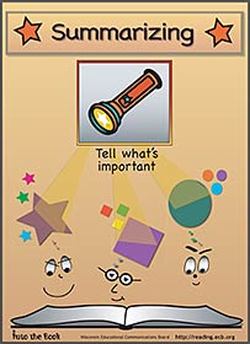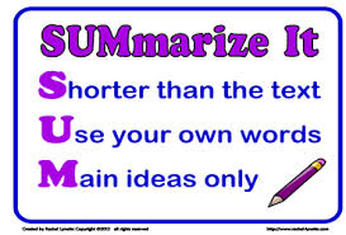What is Summarizing?
Summarizing is when the readers identify key words and the main idea and condense important information into their own words during and after reading to solidify meaning of the text. In other words, the reader is telling what is important (Into the Book, 2015). Students may summarize during reading as well. They may stop after each page and summarize what they have read, to help with comprehension. A successful summary includes the main ideas from the text, and excludes unimportant information. According to the article, Improving Students’ Learning With Effective Learning Techniques: Promising Directions From Cognitive and Educational Psychology, “summarizing boosts learning and retention because it involves attending to and extracting the higher-level meaning and gist of the material” (Dunlosky, J., &…, 2013, p. 14). Summarizing is beneficial for struggling readers because it allows them to think about what they read after every paragraph, page, chapter, or end of the book. This will help students with comprehension. If the teacher asks the students to summarize what they read at the end of the page, then the student might want to go back and reread.
Summarizing is when the readers identify key words and the main idea and condense important information into their own words during and after reading to solidify meaning of the text. In other words, the reader is telling what is important (Into the Book, 2015). Students may summarize during reading as well. They may stop after each page and summarize what they have read, to help with comprehension. A successful summary includes the main ideas from the text, and excludes unimportant information. According to the article, Improving Students’ Learning With Effective Learning Techniques: Promising Directions From Cognitive and Educational Psychology, “summarizing boosts learning and retention because it involves attending to and extracting the higher-level meaning and gist of the material” (Dunlosky, J., &…, 2013, p. 14). Summarizing is beneficial for struggling readers because it allows them to think about what they read after every paragraph, page, chapter, or end of the book. This will help students with comprehension. If the teacher asks the students to summarize what they read at the end of the page, then the student might want to go back and reread.
Visual Representations
|
|
This video explains exactly what is in a summary. A summary is telling the main idea, but HOW can readers tell what is most important in a story? Readers should ask themselves who is in the story, what happens (problem), when it takes place, where it takes place, why the characters want to fix the problem, and how the problem is resolved. This video mentions that a summary is using as little words as possible.
|

This is a poster that teacher could put up in their classroom to help remind students what summarizing is, and how to do it. On the poster it says, “tell what’s important.” To have a well-written summary, the students should write what is important and exclude unimportant information.
|
The image to the left tells us what a summary is. It highlights the word “SUM,” because when readers summarize what they have read, they are “summing it up,” or finding the gist. This poster mentions that students should use their own words when they are summarizing. Often times, students will use direct quotes from the text to summarize what they had read.
|
Four Content Area Examples
Science- This strategy could be adapted by having the students read a science article. They may have a highlighter so as they read they might want to highlight the main ideas in the text. Once they are done reading the students could then write a summary about what they had read. This will help them comprehend the article and have deeper understanding of the text.
History- Summarizing could be incorporated into a history lesson by assigning each students a reading about a different president. The students will have to read about their assigned president, and then compose a short summary to share with the class. This strategy will allow students to learn about all of the presidents without actually reading about all of them.
Reading- Summarizing is a reading strategy and could be used in a reading lesson almost every day. Summarizing increases students ability to comprehend what they read. Teachers could walk around the room as students are reading in their book during quiet reading time. The teacher can ask the students to tell them a quick summary of what they have read so far. If the student does not remember what the book is about and can’t summarize what they have read, then the teacher might want to give the students an easier book, or reassess the student to find their correct reading level.
Math- This strategy could be adapted into a math lesson by assigning a reading to the students about a new unit. At the beginning of each unit there is usually a quick reading introducing what they will be learning about. The students may read the short introduction, compose a summary, and share what they wrote with a partner. Having the students read it, write a summary, and share it, allows them to see it three times. Repetition is key when learning new information. This example of summarization would help the students comprehend what they had read, and deepen their understanding.
Science- This strategy could be adapted by having the students read a science article. They may have a highlighter so as they read they might want to highlight the main ideas in the text. Once they are done reading the students could then write a summary about what they had read. This will help them comprehend the article and have deeper understanding of the text.
History- Summarizing could be incorporated into a history lesson by assigning each students a reading about a different president. The students will have to read about their assigned president, and then compose a short summary to share with the class. This strategy will allow students to learn about all of the presidents without actually reading about all of them.
Reading- Summarizing is a reading strategy and could be used in a reading lesson almost every day. Summarizing increases students ability to comprehend what they read. Teachers could walk around the room as students are reading in their book during quiet reading time. The teacher can ask the students to tell them a quick summary of what they have read so far. If the student does not remember what the book is about and can’t summarize what they have read, then the teacher might want to give the students an easier book, or reassess the student to find their correct reading level.
Math- This strategy could be adapted into a math lesson by assigning a reading to the students about a new unit. At the beginning of each unit there is usually a quick reading introducing what they will be learning about. The students may read the short introduction, compose a summary, and share what they wrote with a partner. Having the students read it, write a summary, and share it, allows them to see it three times. Repetition is key when learning new information. This example of summarization would help the students comprehend what they had read, and deepen their understanding.

